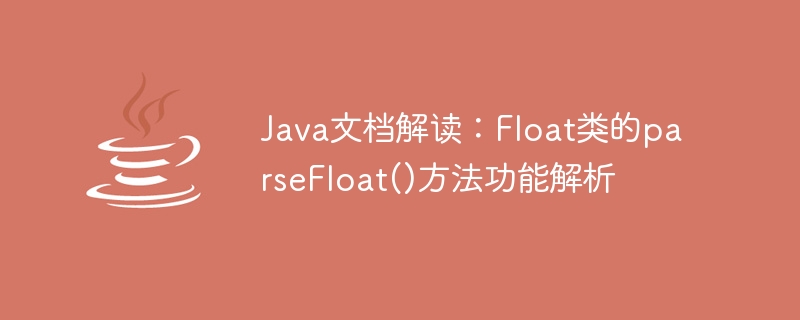

Java Document Interpretation: Function analysis of the parseFloat() method of the Float class, specific code examples are required
Abstract: This article will explain the parseFloat() method of the Float class in Java A detailed analysis is provided, including the function of the method, how to use it, and some sample codes, aiming to help readers better understand and use this method.
1. Overview of method functions
The Float class is a packaging class used to represent floating point numbers in Java. This class provides a series of methods related to floating point number processing. Among them, the parseFloat(String s) method is a static method in the Float class, used to convert string type floating point numbers into the corresponding float type. This method has the following functions:
The above is a brief overview of the functions of the parseFloat() method, which will be further analyzed below through specific code examples.
2. Usage Example
The following is a sample code for using the parseFloat() method:
public class FloatExample {
public static void main(String[] args) {
String str = "3.14";
float floatValue = Float.parseFloat(str);
System.out.println("转换后的浮点数为:" + floatValue);
}
}In the above example, we first define a string variable str, whose The value is "3.14". Then, use the parseFloat() method to convert the string into the corresponding float type value, and assign the result to the floatValue variable. Finally, use the System.out.println() method to output the converted floating point number to the console.
3. Exception handling example
When using the parseFloat() method, if the string contains illegal characters or the format is incorrect, a NumberFormatException exception will be thrown. A sample code for exception handling is given below:
public class FloatExample {
public static void main(String[] args) {
String str = "abc";
try {
float floatValue = Float.parseFloat(str);
System.out.println("转换后的浮点数为:" + floatValue);
} catch (NumberFormatException e) {
System.out.println("字符串格式错误,无法转换为浮点数!");
}
}
}In the above example, we set the value of the string variable str to "abc". Obviously, the string cannot be converted to a floating point number. Therefore, when the parseFloat() method is executed, a NumberFormatException exception will be thrown. We use a try-catch statement block to catch the exception and output the error message in the catch block.
4. Additional instructions for the method
When using the parseFloat() method, you need to pay attention to the following points:
5. Summary
This article provides a detailed analysis of the parseFloat() method of the Float class in Java, including the function, usage and some sample codes of this method. By reading this article, readers can better understand the function and use of this method, so that it can be better applied in actual development.
References:
[1] Java Platform Standard Ed. 8. Float (Java Platform SE 8) - Oracle Help Center.
[2] W3School. Java Float parseFloat() method - W3School Tutorial.
(Note: The above code is only an example and does not consider the actual business scenario and the completeness of exception handling. In actual development, please make corresponding adjustments according to specific needs.)
The above is the detailed content of Interpretation of Java documentation: Functional analysis of the parseFloat() method of the Float class. For more information, please follow other related articles on the PHP Chinese website!
